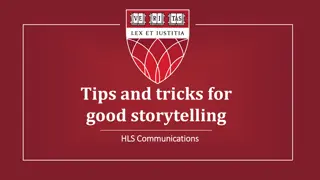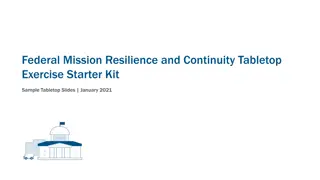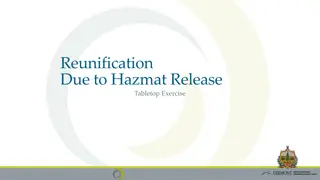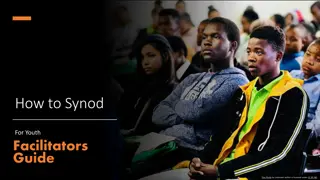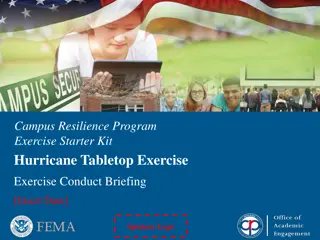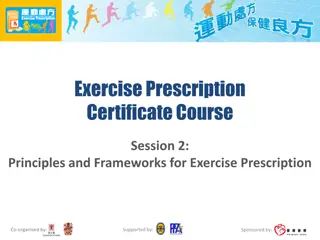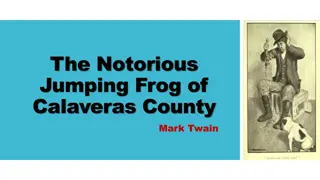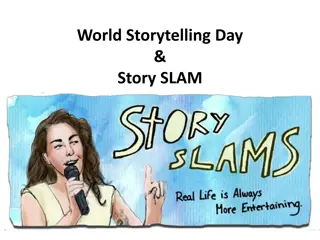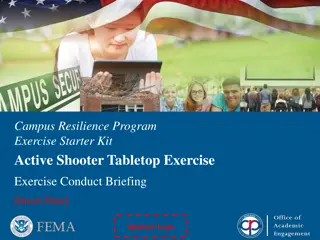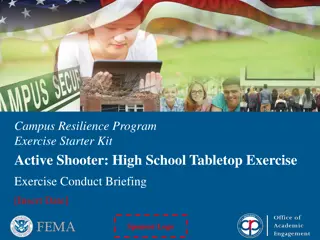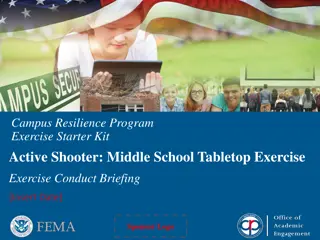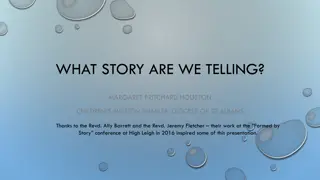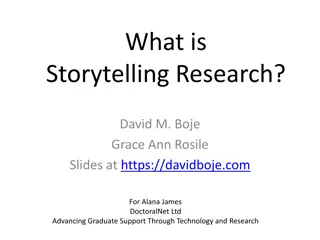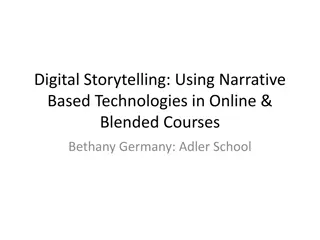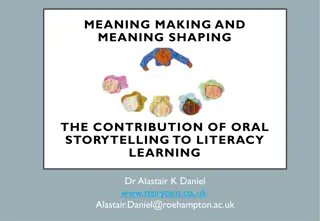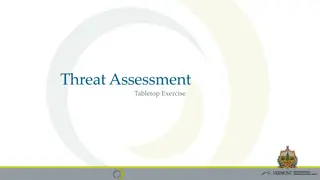Storytelling Exercise: Connecting the Dots Facilitator Guide
This facilitator guide outlines an exercise aimed at enhancing participants' ability to identify connections across seemingly unrelated information pieces and integrate them into a coherent narrative. Through storytelling and sketching, participants learn to recognize the importance of recognizing connections, adapt to new information, and work collaboratively. Facilitator tips stress creativity, critical thinking, and the relevance of uncertainty in problem-solving processes.
Download Presentation

Please find below an Image/Link to download the presentation.
The content on the website is provided AS IS for your information and personal use only. It may not be sold, licensed, or shared on other websites without obtaining consent from the author. Download presentation by click this link. If you encounter any issues during the download, it is possible that the publisher has removed the file from their server.
E N D
Presentation Transcript
Telling a Story Facilitator Guide 1
Telling a Story An Exercise in Connecting the Dots Facilitator Guide Purpose of Exercise This exercise provides practice in identifying connections across seemingly unrelated pieces of information and integrating them into a coherent whole. Estimated Run Time This exercise will take approximately 3-1/2 hours. To reduce the length of the exercise, certain portions of the exercise can be conducted as homework or on one s own time. Summary of Exercise Using a set of 5 images that are seemingly unrelated, participants: Develop a story and sketch that accounts for the information contained in the set of images. Work in small groups and present that story to others. Revise their story, or create an entirely new one, after several images in the set are replaced with new ones. 2
Telling a Story An Exercise in Connecting the Dots Facilitator Guide Learning Objectives Participants will learn to: Recognize the importance of recognizing connections across seemingly unrelated factors in order to understand a complex problem. Recognize that factors that seem unrelated may actually interact and need to be understood in order to anticipate and/or shape the future. Integrate multiple elements together into a coherent whole. Adapt an explanation in the face of new or different information. Relation to Other Exercises It is best for participants to complete this exercise after they complete Questioning for Deeper Learning. Experience with that exercise can help participants ask questions that enable them to identify connections they might not otherwise recognize. Group or Individual Activity This exercise includes activities that require a combination of both group and individual work. 3
Telling a Story An Exercise in Connecting the Dots Facilitator Guide Materials Needed (Facilitator) Five images (selected randomly) for each participant A total of 100 images are provided in the exercise materials. The facilitator will need to divide the participants into small groups of three to four for a portion of the exercise. This will ensure the right mix of images across individuals. Each small group can use the same packet of images. But, each person within a small group should have a different set of five images. Whiteboard and markers. One Participant Guide for each participant. Expert perspective videos (viewable in the Managing Complex Problems Resource: Expert Perspective Videos page, filter by Telling a Story). Materials Needed (Participants) Participant Guide Paper Pen/pencil Markers 4
Telling a Story An Exercise in Connecting the Dots Facilitator Guide Facilitator Tips and Guidance Remind participants there is no right answer. Emphasize that creating a story is about making connections. Encourage creativity in filling gaps and making connections. Ask participants to consider not only what they see, but what they do not see. Reiterate that good art is not important in creating sketches and representations. Note common challenges. Underscore the connection between uncertainty in the exercise and uncertainty in the real world. Intersperse the pre-, mid-, and post-exercise reflection discussions with videos on the topics of systems thinking and synthesis (viewable in the Managing Complex Problems Resource) 5
Telling a Story An Exercise in Connecting the Dots Facilitator Script Instructions The next several pages provide step-by-step instructions for facilitating the exercise, broken down into modules. Each module includes icons to indicate its duration, DO: facilitator actions, SAY: facilitator talking points, and DISCUSS: questions for group discussion (see below for icons). While the talking points are simply intended to guide the facilitator, we recommend including them to achieve the intended learning outcomes. Talking points that are listed directly under an action are meant to assist the facilitator with that given action. Also, optional break points are indicated at the end of certain modules. Some modules also include clickable links to the exercise slide deck that supplement the facilitator guide. We recommend referring to the accompanying slide content while guiding your group through this exercise. Module SAY DISCUSS DO Duration 6
Step Facilitator Activity 1 DO - Exercise Set Up Distribute and describe Participant Guide. SAY - 30-40 min Today we are going to practice our systems thinking and information synthesis skills. This guide contains information you will use throughout the exercise. I ll let you know when you need to turn to a particular section. Also, you can take this with you after the exercise. - DO - Conduct pre-exercise reflection. Direct participants to the Participant Guide and describe the task. SAY - Before we get started, please flip to the Pre-Exercise Reflection section of your Participant Guide. For many of us, connecting the dots and recognizing connections can be a challenge. Take a few minutes to think about the questions listed there before we discuss them as a group. DO - View Value of Telling a Story Exercise and sampling of other expert perspective videos on systems/holistic thinking. Access through the Managing Complex Problems Resource: Expert Perspective Videos page, filter by Telling a Story. 7
Step Facilitator Activity 1 Exercise Set Up (contd.) DISCUSS - Guide the group through a discussion using the questions for group discussion below: - Can you think of an example from your own experience where you figured out how certain factors or pieces of information fit together into a bigger picture? - What made recognizing connections and integrating the pieces together difficult? - What helped you recognize and understand the connections? - How do you think synthesis and systems thinking can help you with strategic thinking? 30-40 min DO - Provide brief tutorial. See supporting slides. - [Note: Facilitator may decide to present tutorial verbally, print the slides, project PowerPoint, or some combination thereof.] 8
Step Facilitator Activity 1 Exercise Set Up (contd.) DO - Describe the exercise. SAY - 30-40 min In this exercise, we are going to be working with images. In a few minutes, I m going to give each of you a set of images similar to these [hold up examples from the Telling a Story Images slide deck so participants can see what you mean by images ]. Your task will be to develop a story an interpretation or narrative of how the images might fit together. You may find It pretty challenging to come up with a story without more information. It may seem awkward or uncomfortable. Remind yourself that being able to create a narrative or interpretation about what s going on in the environment, and doing that even if you don t have complete information is part of what we need to be able to do in real world operations, So, it s important to practice. Part of what you re going to be practicing here is using the information you do have in order to come up with a plausible interpretation. - - - 9
Step Facilitator Activity 1 Exercise Set Up (contd.) DO - Ask participants to form small groups of three to four people; the groups will work together later in the exercise. [Note: They can self-form the groups, or you can count off to determine group membership.] - 30-40 min DO - Continue exercise description. SAY - In a few minutes, I m going to give each of you five images. Everyone in your small group will get a different set of images, so you will each have your own set to work with. The images reflect a variety of different situational factors, from military factors to social, political, cultural, economic, technological, and others. Once you have the images, I d like you to spend some time thinking about how they could be connected: - What threads might weave through all of these images? - How might they be inter-related? - What story or big picture might they represent? - 10
Step Facilitator Activity 1 Exercise Set Up (contd.) SAY - Your task is to create a plausible story that accounts for all the images. There is no right or wrong answer. The 5 images you happen to receive are randomly selected, so there s not a correct story to discover. The point of the exercise is to practice your skills in figuring out the possible connections across factors that may seem unrelated. There are lots of ways you might interpret these images. For example, an image of a tornado might represent general weather conditions. Or you might think about it as a metaphor for chaos or confusion. Or it could represent a strong force moving through a situation. There are many different ways to think about what s going on in each image. You can also arrange the images in whatever order makes sense to you, to help you think about them as a coherent whole. Think about what you see in the images but also what you don t see. Sometimes, the most important information for understanding a situation is the information that s missing. Be creative in thinking about where the gaps are and how to fill them in order to identify potential connections across the images. 30-40 min - - - 11
Step Facilitator Activity 1 Exercise Set Up (contd.) SAY - For example, perhaps one of your images is a boat in the distance. Perhaps part of the story you create is that there is a stowaway in the boat, even if you do not actually see a stowaway depicted in the image. Feel free to fill in the blanks as you create your story. 30-40 min [End of Step 1] 12
Step Facilitator Activity 2 Developing the Story DO - Provide instructions for the next part of the exercise. 30-35 min SAY - Once you ve examined the images, you will have 20-30 minutes to individually develop 1) a story of how the images fit together and 2) a rough sketch that shows the connections and represents the whole set. The sketch does not need to be good art or PowerPoint ready. The purpose is to help you develop your interpretation and communicate it to others. Please turn to the Image Review Considerations section of your Participant Guide. When I give you your set of images, I d like you to flip your images over one at a time. Spend about a minute with each image, asking yourself the questions in Part 1 of the Image Review Considerations for each image. For example: - What does the image depict; what concepts might the image represent? - Who are the key players, where are they located in the scene, what are they doing, and why? - - 13
Step Facilitator Activity 2 SAY - - Does the image suggest a particular location, time of day, or season? Think about what that information might mean in terms of understanding what s going on. - What might be going on outside of the frame of the image, and what might that mean for what s going on inside the image? - The point of looking at each image individually for a couple of minutes is to give yourself an opportunity to appreciate all the layers of information the picture contains. Also, think about not only what you see in the image; think also about what you don t see. Developing the Story (contd.) [Examples contd.] 30-35 min DO - - Distribute images. [Note: Provide each participant with a set of 5 images. Pass the images out randomly, without attention to image content, akin to dealing a hand of cards from a card deck. Pass the images out so they are turned upside down and the participants can t see them yet. Do not duplicate images within each small group. However, the same set of images can be used across small groups. One way to manage this is to make 1 copy/group of the 100 images provided in the exercise materials. Images distributed within each small group come out of that set of 100.] 14
Step Facilitator Activity 2 Developing the Story (contd.) SAY - Here are your images, and again, everyone in your small group has a different set of images to work with. 30-35 min DO - Ask participants to work independently to develop a story and a rough sketch. SAY - You can start now; flip over 1 image at a time and spend about 1 minute looking and thinking about that individual image, using questions on page 3 of your Participant Guide to prompt your thinking. [Give participants approximately 5 minutes to review the images] Now that you ve had a chance to look at each image, you are going to work independently to develop a story and rough sketch that ties them together. As you do this, use the questions in the Image Review Considerations: Part 2 section of your Participant Guide to prompt your thinking. For example: - When you look across the full set of images, what questions occur to you? - - 15
Step Facilitator Activity 2 Developing the Story (contd.) SAY [Example questions contd.]: - Think about how the images might be connected to each other. How are the concepts or relationships you identified in the individual images connected? - Think about connections among the images the connections that are explicit and obvious and those that are implicit, indirect, or subtle. - What story do the images tell? What narrative takes account of all of the images? - As you develop your story and rough sketch, remember that there is no right or wrong answer in this exercise. The point is to identify possible connections among these images and create a plausible story that ties the images together into a whole. 30-35 min [End of Step 2] 16
Step Facilitator Activity 3 Participants Present Story DO - Ask participants to reconvene in their small groups. DO - Ask each participant to briefly present their images, story, and sketch to their group. 25-30 min SAY - Now, each of you is going to present your story and sketch to the rest of the group. Your presentation should be five minutes or less. As others present, I encourage you to ask questions or provide comments that build on their story or sketch. Maybe you see a relationship the presenter hasn t mentioned; or maybe you have a clarifying question (e.g., How is your sketch related to your description? I m not getting the connections there. ). Your questions should focus on helping the presenter clarify and expand on their story. - [End of Step 3] 17
Step Facilitator Activity 4 Mid- Exercise Reflection DO - Ask participants to flip to Mid-Exercise Reflection in their Participant Guide. View videos: How an expert ties images together and How an expert adapts his understanding when presented with new images. Access through the Managing Complex Problems Resource: Expert Perspective Videos page, filter by Telling a Story. - 25 min SAY - Please read through the questions on this page and jot down your responses. We re going to take about 10 minutes for you to work individually. [Allow participants 10 minutes for work] Now I d like you to discuss your responses and thoughts with your small group. - - [End of Step 4] - BREAK - 18
Step Facilitator Activity 5 Participants Change the Story DO - Describe the next segments of the exercise. SAY - 45 min In operational environments, we are constantly faced with incoming data that we need to somehow incorporate into our current understanding. Next, we re going to practice how to re-examine and adjust that understanding when information changes. SAY - I d like you to turn your images face down and shuffle them. Choose any two images and pass them to the person on your left. When you re done, everyone in the group should have a new set of images. I d like you to consider: How do these two new images change your story? How might this new set of images be tied together into a coherent story? What you come up with might be a modification of your previous story, or it might be a new story altogether. Once again, create a story that describes the connections among the images. - - - 19
Step Facilitator Activity 5 Participants Change the Story (contd.) SAY - [Allow participants approximately 15 minutes to work independently.] Now, present your new story to your small group. Again, I encourage you to ask constructive questions or share comments with the presenter. I d like you to do this fairly quickly, in 5 minutes or so. - 45 min [End of Step 5] 20
Step Facilitator Activity 5 Participants Develop a New Story [Note: This is an alternative to the previous Step 5: Participants Change the Story. If participants are repeating the exercise in order to continue building skills, the facilitator might consider using this alternative step as a way to vary exercise content. This alternative allows participants to practice the skill of breaking out of a current mindset to think about a set of data in an entirely new way.] 20-30 min 21
Step Facilitator Activity 5 Participants Develop a New Story (contd.) DO - Describe the next segments of the exercise. SAY - In operational environments, we are constantly faced with incoming data that we need to somehow incorporate into our current understanding. Next, we re going to practice how to re-examine and adjust that understanding when information changes. 20-30 min SAY - I d like you to turn your images face down and shuffle them. Choose any two images and pass them to the person on your left. When you re done, everyone in the group should have a new set of images. Now that you have some new information, I d like you to consider what sometimes happens in operational settings. Sometimes, we start with an interpretation of a situation or event, and we hold onto that interpretation and try to fit the new information into it. Sometimes we have blind spots and are unable to discard our original interpretation or frame . - - 22
Step Facilitator Activity 5 Participants Develop a New Story (contd.) SAY - The problem is, in some cases, that original interpretation may no longer be accurate. In order to grasp what the new data might mean, it can be important to break away from our current mindset and look at the information in an entirely new way. 20-30 min DO - Provide instructions for the next activity. SAY - I d like you to take your updated set of five images and come up with an entirely new story. I don t want a story that is just an updated or revised version of your previous one. I d like a radically different story that could account for the new set of five images. [Allow participants approximately 10 minutes to work independently.] Now, please present your new story to your small group. - - [End of Step 5] 23
Step Facilitator Activity 6 DO - Final Reflection & Debrief Ask participants to flip to Final Reflection in their Participant Guide. SAY - 25 min I d like you to first work individually to consider and write your responses to each of the questions provided in this handout. Then we will discuss them as a group. DISCUSS - Guide the group through a discussion using the following questions: - Think about what you learned from this activity. How might you approach this activity differently next time? - What was difficult about connecting the images into a coherent story? What helped you to do so? - How might you apply these skills in your personal life and/or work? - Think about the information you see or hear in briefings, on the news, or from other sources. How might you think differently about making sense of information, based on your experience here? [End of Telling a Story Exercise] 24




